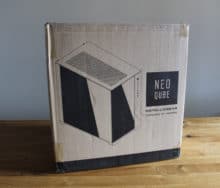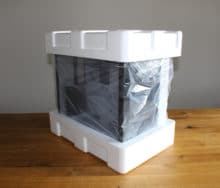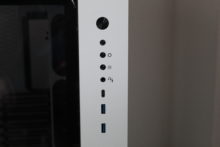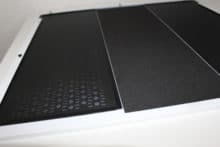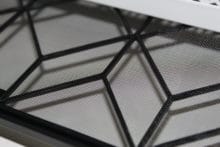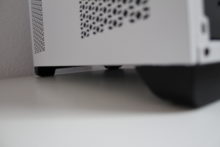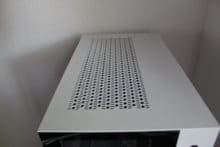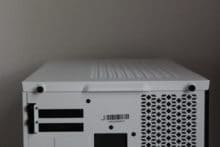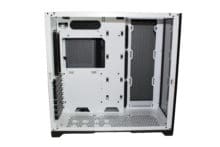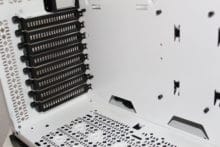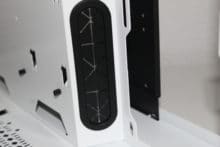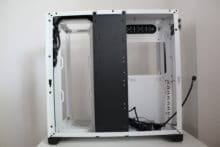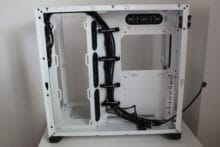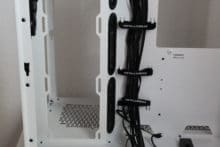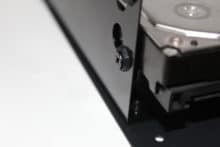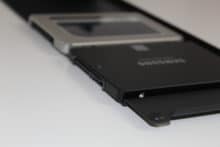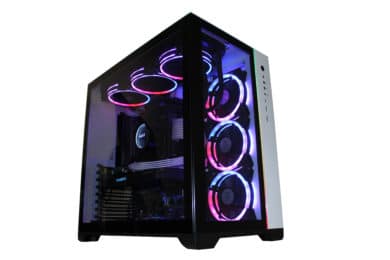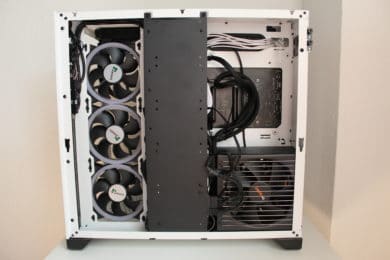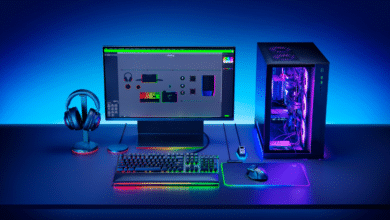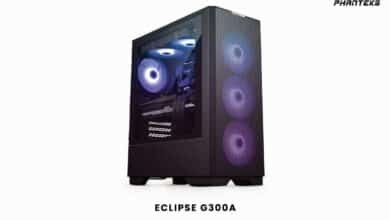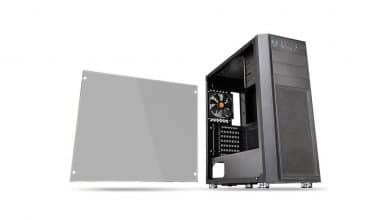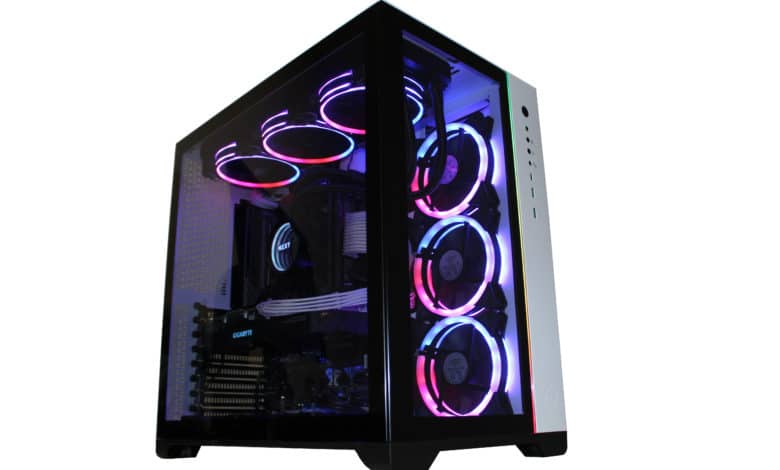
The NEO Qube from MetallicGear shows a lot of hardware – through a glass front and a glass side panel. MetallicGear belongs to Phanteks, so it is more likely to be one of the big and well-known brands and tries with this case, as Inter-Tech did with the C-701 Panorama, to create a competitor to the very popular Lian Li O11 Dynamic.
Specifications
| Case type | ATX |
| Dimensions (LxHxW) | 450 mm x 460 mm x 270 mm |
| PCI-Slots | 8, removable |
| Available colors | white, black |
| Front connectors | 2x USB 3.0, 1x USB 3.2 Gen 2 (Type C), microphone, headset, RGB button |
| Drive bays | 2x 3.5″, 5x 2.5″ |
| Form factors | E-ATX, ATX, µATX, Mini-ITX |
| Fan | side: 3x 120 mm Top: 3x 120 mm or 2x 140 mm Bottom: 3x 120 mm or 2x 140 mm |
| Radiators | side: 360 mm Top: 360 mm or 280 mm Bottom: 360 mm |
| Max. CPU cooler height | 148 mm |
| Max. graphic card length | 425 mm |
| Price | € 111.75 * (black), € 72.69 * (white) |

Scope of delivery
The case is shipped in a rather plain brown cardboard box. It is printed with an image and specifications of the product. If you remove it, you will find the case, which is protected by polystyrene and a film for transport. This is a reasonable way to ensure that the case arrives at the customer with intact glass side panels and no other damage.
Inside the case you will also find a manual and a small box with further accessories – seven black cable ties and all necessary screws. To open the case, you first have to loosen the knurled screws for the cover, then you can remove the side parts. This is in the manual, but you have to open the case to get an explanation how it works.
Pre-assembled are already dust filters on the right side and in the bottom of the case. As usual with cases of this kind unfortunately no fans are pre-assembled or generally included.
Outside impression
The first impression is dominated by all the glass. Through the completely glass front you get an even deeper insight into the inside of the case. The tempered glass panels have a black frame and are embedded into the rest of the tower from above. They are firmly seated and nothing wobbles.
Magnetic dust filters are pre-installed inside the lid as well as in the right side wall made of metal. These have a fine mesh and because they are magnetically attached from the inside, they are not noticeable.
Basically, there are hardly any optical differences compared to the Lian Li O11 Dynamic – the front IO panel is also on the front of the case and the lid and the back are dominated by ventilation holes. These are in the same honeycomb-like design at all points and look chic. The front IO contains the power button, a reset button including HDD LED, two USB-A ports (USB 3.0), one USB-C port (USB 3.1) and one headphone and microphone port each. In addition, there is a narrow RGB strip in the front, which can be changed by default using the RGB button. This looks noble and the colors are strong.
Inside impression
From the inside the whole case looks very tidy. This is primarily achieved by installing a second chamber for the power supply, which is located behind the mainboard – so this is completely invisible, not even a usual chamber at the bottom of the case is visible.
Around the mainboard mounts there are rubberized cable bushings. With the help of these the cables can be managed well and guided sensibly. Also the three fans, which have slipped from the usual position in the case front to the side, are mounted directly at the cable ducts.
Behind the mainboard, in the second chamber, the power supply unit can be installed upright. There are also mounting options for SSDs and hard drives – on a frame that also hides cables. Basically, this is very comfortable, but if you use cable extensions to optically enhance the overall picture, it becomes borderline from the available space. Unfortunately, unlike other cases, not the whole backside can be used for cable management, because this would be visible through the side mounted fans.
This case can be illuminated very well by nine positions where 120 mm fans can be installed – especially the already mentioned glass front offers many possibilities.
Here, too, the impression that was already noticeable from the outside is repeated – many differences to the Lian Li equivalent are sought in vain. Nevertheless, there are some that serve a different niche. Because in contrast to the second power supply in the Lian Li, in theory a second system can be installed in the small form factor in the NEO Qube. Theoretically a nice idea – but there are some obstacles. The biggest problem points are the power supply and the space. To really use the system, you need a power supply that is actually designed for it, because of course you need two 24-pin mainboard connectors and 4- or 8-pin CPU (EPS) connectors. Unfortunately there is not enough space for a second power supply. Phanteks can of course offer this if required. In addition, everything becomes quite narrow, the ventilation is not ideal – but basically sufficient and possible.
So if you want two PCs in one case, for example for a separate streaming PC – here you would definitely have the possibility.
system installation
The test system consists of a Ryzen 5 3600 enthroned on a MSI B550 Tomahawk. The CPU is cooled by a NZXT Kraken X73. The whole thing is installed with 16 GB RAM and a GIGABYTE RX 5600 XT GAMING OC. A good case ventilation is provided by some Wing Boost 3 ARGB and Inter-Tech RS-04.
Basically it can be said – as roomy as it looks, it is in the front as well. The installation is very comfortable, because you have enough space for wiring. The hardware can be placed well and also the fact that there is still a lot of space above the mainboard makes life easier. But on the back side it gets quite narrow as already mentioned. The case for the SATA SSDs gets a minus point – here the connectors are directly in front of the power supply and have to fit very tight. This requires some effort and power to close the case.
Finally, the performance test should not be missing. We put the MetallicGear NEO Qube in direct comparison to the Fractal Design Define 7. To heat up the case we used Furmark and Prime95. Afterwards we measured the temperatures of the GPU and CPU. For better comparability seven identical case fans were used in both cases. That’s a lot – but for a showcase of this kind still “little”.
| Cases | CPU temperature | GPU temperature |
| MetallicGear NEO Qube, 50% case fan | 67°C | 47°C |
| MetallicGear NEO Qube, 100% case fan | 65°C | 46°C |
| Fractal Design Define 7, 50% | 78°C | 52°C |
| Fractal Design Define 7, 100% | 72°C | 51°C |
The test is more than passed – even if the Define 7 tends to be a warmer case – the NEO Qube clearly wins. The many ventilation holes are quite large and the mesh is not too restrictive. There’s no criticism from our side – you can’t expect much more without a mesh front.
Conclusion
In summary, the case makes a very good impression. Unfortunately, however, the constant comparison with the Lian Li O11 Dynamic doesn’t stop there – it looks too much like it. MetallicGear, or Phanteks actually stands out almost only because of the theoretical possibility of a second system in the case and the RGB strips in the front – and the lower price.
Nevertheless, it is and remains a good case – it is convincing when viewed individually. You get high-quality materials, an appealing look and a very solid workmanship at an acceptable price. In the end, however, it remains a basic question – do you choose the “original” and pay a little more, or do you take the cheaper variant that can definitely keep up?
So you get a lot – magnetic dust filters, two Tempered-Glass side panels and an appealing look. As a case, which you want to integrate into your setup, it is therefore very suitable. It deservedly receives the Gold Award from us and thus a clear recommendation.
MetallicGear Neo Qube
Workmanship
Structure
Features
Dampening
Cooling
Value for money
90/100
Beautiful showcase case with clear design origin. Nevertheless high-quality workmanship and a real eye-catcher.



